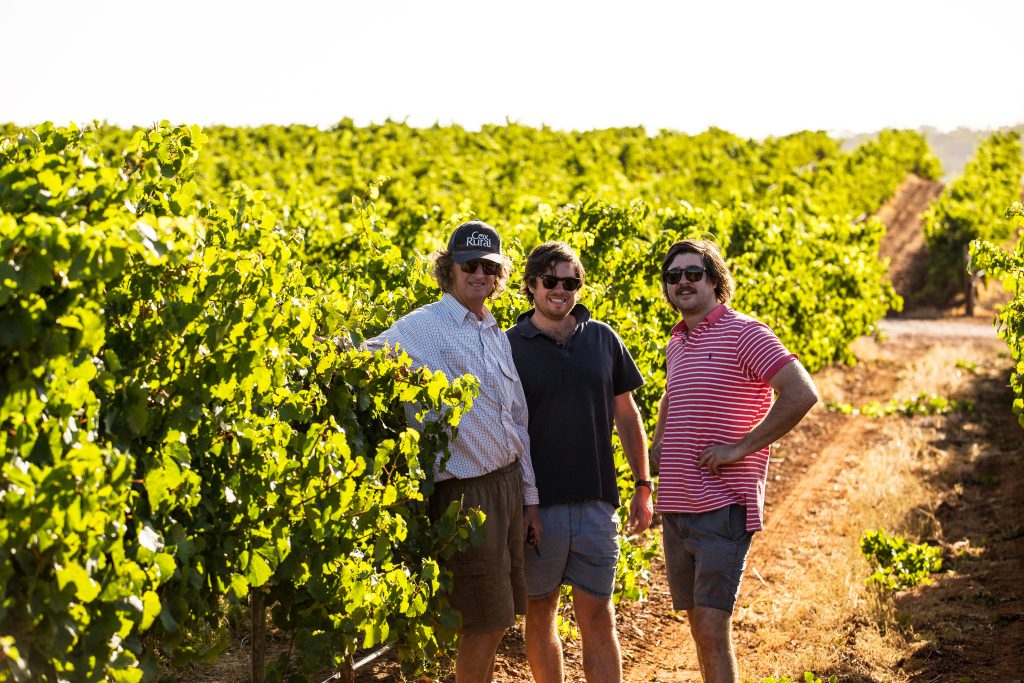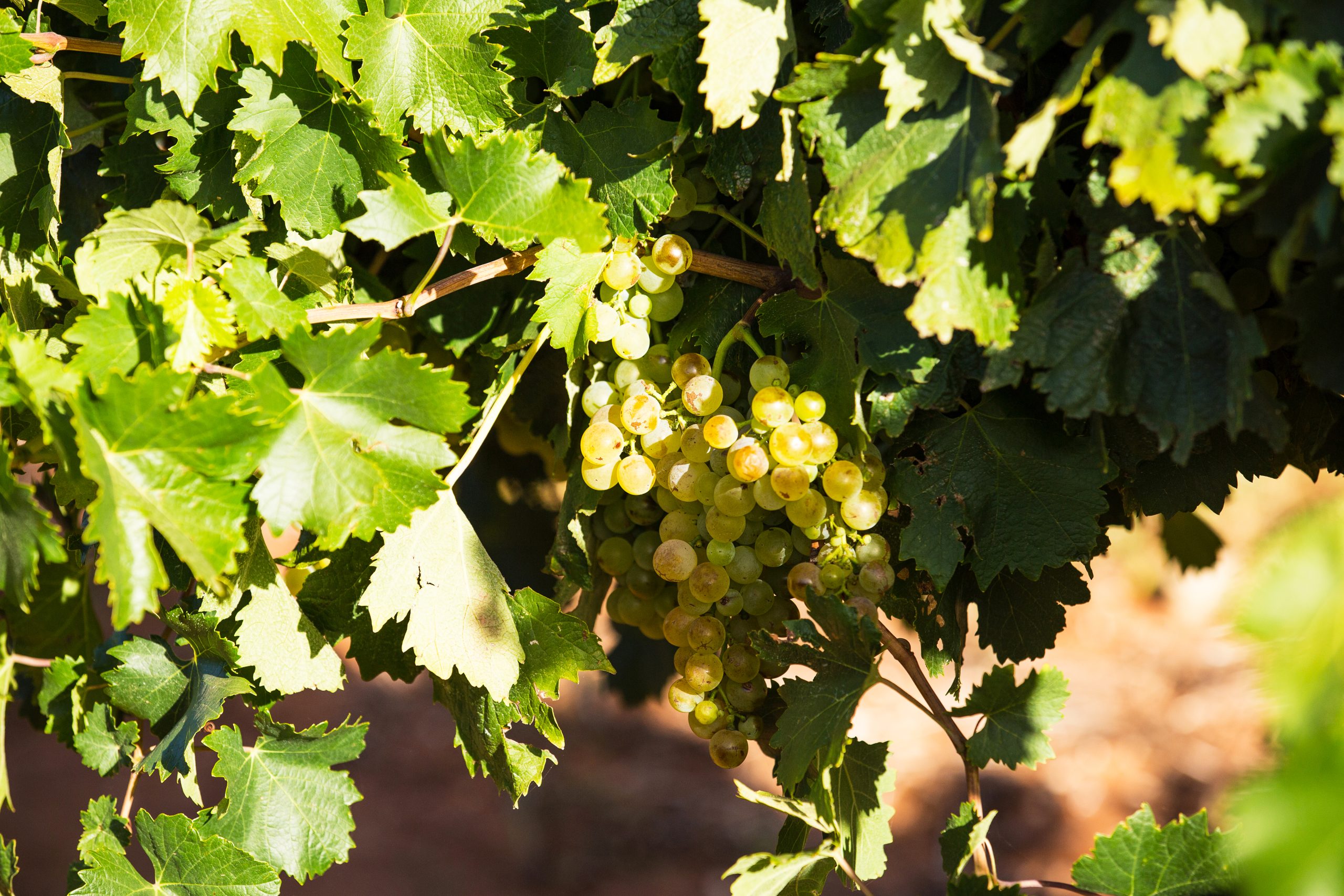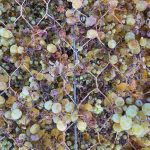Vermentino Grapes: Photo Jono Koerner
Warming temperatures and harsher conditions are forcing Australian producers to look to varieties that can stand up to the conditions – and many are looking toward Vermentino. Harrison Davies explores the variety that is being heralded as part of the future for Australian whites.
As is the case with many alternative varieties, Vermentino finds its roots in the Mediterranean. Sardinia to be specific.
The grape is late ripening and prefers infertile soils, commonly found in coastal areas that are rich with salt and sun.
Vermentino is a notoriously versatile wine, and its flavours can alter significantly depending on the time it was harvested and the techniques used by the winemaker.
Many viticulturists pick the grapes early, as they had a tendency to lose acidity as it approaches ripeness and early harvest results in a wine that seems like a cousin to Sauvignon Blanc.
However, many Sardinian growers get it to go to full maturation and even wait for the berries to shrivel slightly before harvest. This results in a fuller, more fruit forward style with a saline thread throughout.
Nearly half of all
Vermentino wine in
the world is made in
Sardinia – Cheers to that!
The conditions in Sardinia are similar to many of those found in Australia. Beating sun and coastal breezes which force the grape to stand up to challenging environmental forces
The origins of the variety are disputed, and its true age isn’t known, but the earliest known records of the grapes go back to the 17th century in Piedmont. Other sources claim the variety was born in Spain and was brought to Italy later on. Further theories suggest places like Greece.
Italian Wine Society founder and sommelier Daniel Marcella said the history of the variety was disputed and traces of its past can be found all over Europe.
“It’s hard to mention the exact place where Vermentino was first planted, as some experts speculate it was brought from Spain or that Italians cultivated and then brought it to Spain later,” he said.
“Tracks of proto viticulture from the Nuraghi period (1000-1400 AC) were found in Gallura, yet it’s hard to identify whether it was the Vermentino grape.

“Today, we recognise the area of Gallura in Sardegna as the ‘home’ of Vermentino, where it finds its best expression on the local granite soils.
“Vermentino produces beautiful fatty wines with great saline hints, typical of its area of origin with a creamy texture.
“The aroma is mostly of apricot, peach and florals. Most producers love short pellicular maceration and stainless steel fermentation (barrel fermentation used by a few) while battonage is also increasing.”
Sardinia is best known for Vermentino and it is also the principal white variety from Liguiria on the north coast of Italy.
The variety was first brought to Australia in 1947, when it was known as Rolle, its French name, but was only used for white blends.
The variety was not brought to Australia for use as a wine unto itself until 2001.
“It’s hard to
mention the
exact place where
Vermentino was
first planted, as
some experts
speculate it was
brought from
Spain or that
Italians cultivated
and then brought
it to Spain later.” – Daniel Marcella
Australian origins
Vermentino is characterised for its ability to grow in high temperatures and poor soil. It was identified by many as a variety that could grow well in Australia but wasn’t embraced by Australian producers until the 21st century.
In an interview with the ABC, University of Adelaide viticulture lecturer Vinay Pagay said that Australian producers might be looking to Vermentino for a variety of reasons.
“If you have a short season because you have these extreme temperature events, you want a late-ripening variety,” Pagay said.
“Vermentino is certainly one of the later-ripening white varieties, almost as late as some reds.
“I think part of the interest is exploring new varieties for new millennials … they definitely don’t want to be drinking what their parents drank, like a Chardonnay or Sauvignon Blanc,” Dr Pagay said.
“There is obviously this curiosity and an interest in exploring or they’ve tried it during their travels in Europe and it’s now available in Australia.”
There are two clones of Vermentino that are typically grown in Australia: VCR 1 and VCR 367. VCR 1 was the first one brought to Australia and was planted by Chalmers in 2001.
Chalmers director Kim Chalmers recalled their experience growing the vines and making Australian Vermentino for the first time.

sommelier Daniel Marcella.
They had imported a swathe of Italian varieties and were experimenting with several types before signalling out Vermentino as something that really agreed with the Australian climate.
“We were not familiar with the wines of Italy, it was more about the viticulture. When all these varieties arrived, we established mother books and our original nursery vineyard in Houston,” she said.
“We could see which lines were performing well or not in our climate there and from those that were doing well, we decided to make wines.
“Vermentino was just a stand out from the beginning, it made sense.
“It grew really well in the hot, dry conditions, and produced nice big berries… it was also reasonably drought tolerant, and just the main thing was the ability of the variety to make really fresh, lower alcohol aromatic wines.”
Vermentino can be
found under many
different names, such
as Rolle, Pigato and
Favorita, most likely
due to the squabbling
over the grape’s
historical roots.
Since then, more producers in regions like Clare Valley, McLaren Vale, Adelaide Hills, Margaret River and Hunter Valley and adopted the variety due to its resistance to heat.
Tastes have also changed, with consumers seeking out lighter, fresher wines compared to 20 years ago.
“There’s an interest in being able to grow grapes in a warming climate,” Chalmers said.
“Chardonnay is very happy growing in all kinds of conditions, but it’s about the style of wine you make and the way you manage it.
“Chardonnay doesn’t mind the sun, but you’re not going to get a new, really elegant drop; it’s probably going to get a more fruity style with lower acidity and all that sort of stuff.”
Chalmers described the evolution of Vermentino in her vineyards, and how the method upon which the berries are picked and processed haven’t been changed as much as attitudes and understanding has.
Vermentino is known for its texture and as it has become more known, more producers are steering into that flavour profile when making the grapes into wine.
“It grew really well in the hot, dry conditions, and produced nice big berries… it was also reasonably drought tolerant, and just the main thing was the ability of the variety to make really fresh, lower alcohol aromatic wines.” – Kim Chalmers
“We’ve always had that herbal element and the sea spray and the chalky stuff,” Chalmers said.
“Some of the early Vermentino were really honing in on the freshness and the aromatics and perhaps losing some of those textural elements that are so beautiful about them.
“Now people are really getting on the bandwagon of texture without expense of freshness which is great.”
Producers had also noted its synergy with other whites. The Adelaide Hills and Clare Valley based Brothers Koerner planted Vermentino Vines in 2009 alongside their Riesling rows in Watervale.
Winemaker Damon Koerner said his father, who planted the vines and was supplying grapes to winemakers at the time, was looking for something different to offer those who bought the Riesling.
“He was on the money,” Koerner said.
“The vine handles the heat very well. It has big leaves that create a good amount of shade for the fruit and doesn’t require huge amounts of water.
“The berries that do see the sun actually provide the wine with interesting flavours through skin contact.”
Koerner began making wine from the fruit in 2013 in small batches and has since expanded his operations.
He said that the flavours the fruit produced alongside the skins and solids were unique.
“I find the juice on its own can be a bit neutral. The skins bring in some fresh flavours, lemon and lime, peach iced tea, sea spray,” he said.
The solids add more lemon curd, oyster shell, fresh sea water like flavours.

Vermentino now
Vermentino has seen significant growth in the Australian market in the last decade, becoming a more prominent alternative variety each year.
Its growth in the local market can be observed by entries at the Australian Alternative Varieties Wine show, where it began as simply a part of the extended white category.
Since its first entry in the mid 2000s as part of the ‘Other Whites’ category, Vermentino now has two categories to itself, encompassing over 40 entries each year from across the country.
Australian Alternative Varieties Wine Show business, marketing and show manager Helen Healy said the variety has become a big part of the show.
“Vermentino over the years has expanded from being thrown in with Other Whites until it got its own class in 2009, which coincidently was the year we graduated Pinot Gris/Grigio which had grown to encompass four classes by that time,” Healy said.
“By 2014, a Vermentino won the Chief of Judges Wine to Watch (Davis Premium Vineyards Rogue Series Hunter Valley Vermentino) and the Best Murray Darling Region Wine (Calabria Private Bin Vermentino) and in 2015 the Golden Grove Estate 2015 Vermentino won a swag of awards including Best Wine of Show.
“It has remained a staple since that time and in recent years has stabilised to around 6 per cent of entries.”
Marcella said the variety puts on display the conditions in which it was grown and that he was eager to see what direction the variety went in the future.
“Today Vermentino represents a strong identity of Italy and, of course, a dynamic pairing. In particular with pasta and sea urchin,” he said.
“You’ve got to try Vermentino because it represents one of the most exciting and pure expressions of the Italian terroir with its salinity and Mediterranean flavours.”
Australian Vermentino has a bright future and experiments are being done with the variety by both young and veteran producers due to its hardiness and versatility with climate.
Warming temperatures invite newer, fresher styles and Vermentino could provide producers with flexibility to make warm climate whites in the future.
Koerner said Vermentino was a great way for wineries to adapt their repertoire to the changing conditions.
“We are definitely seeing more wineries adapt to the changing conditions, which is not only climate based but also consumer based,” Koerner said.
“I dare say we’ll see lots more of these styles of wine entering the market over coming years, which is great to see as it helps continue to create Australia’s wine identity.”
Chalmers looked forward with optimism.
“We like the kind of crispness and freshness we get from the inland growing and we have cooler nights during the ripening season, which I think contributes somewhat to the kind of aromatic profile that we can get out of [the grapes],” she said.
“I would definitely say you want to stay somewhere that’s got nice sunny summers.
“I think what the beauty of Vermentino is that you can do quite a lot with it.”
To view the current issue of the Grapegrower & Winemaker, visit our Current Issue page.





















